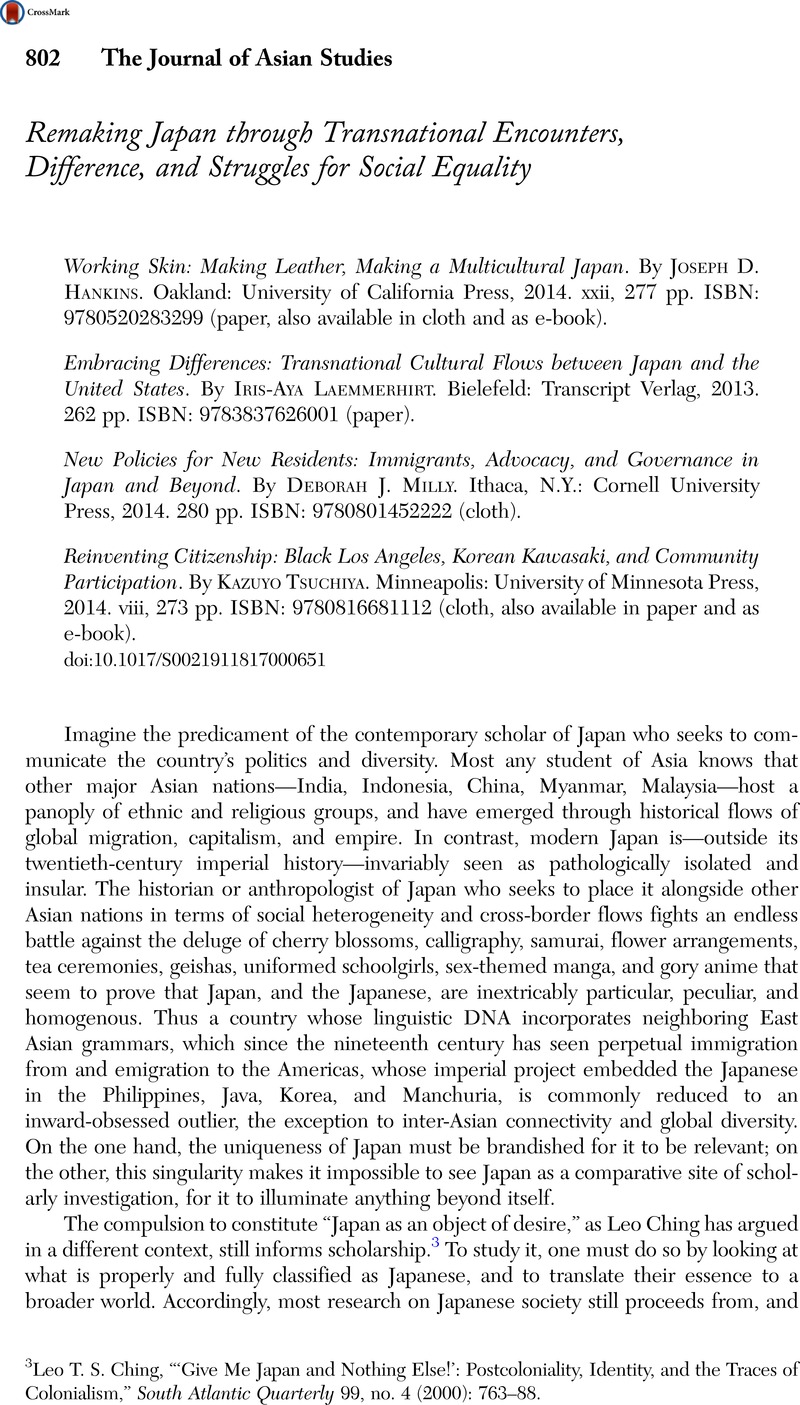No CrossRef data available.
Article contents
Remaking Japan through Transnational Encounters, Difference, and Struggles for Social Equality - Working Skin: Making Leather, Making a Multicultural Japan. By Joseph D. Hankins . Oakland: University of California Press, 2014. xxii, 277 pp. ISBN: 9780520283299 (paper, also available in cloth and as e-book). - Embracing Differences: Transnational Cultural Flows between Japan and the United States. By Iris-Aya Laemmerhirt . Bielefeld: Transcript Verlag, 2013. 262 pp. ISBN: 9783837626001 (paper). - New Policies for New Residents: Immigrants, Advocacy, and Governance in Japan and Beyond. By Deborah J. Milly . Ithaca, N.Y.: Cornell University Press, 2014. 280 pp. ISBN: 9780801452222 (cloth). - Reinventing Citizenship: Black Los Angeles, Korean Kawasaki, and Community Participation. By Kazuyo Tsuchiya . Minneapolis: University of Minnesota Press, 2014. viii, 273 pp. ISBN: 9780816681112 (cloth, also available in paper and as e-book).
Review products
Published online by Cambridge University Press: 08 September 2017
Abstract

- Type
- Book Reviews—Japan
- Information
- Copyright
- Copyright © The Association for Asian Studies, Inc. 2017
References
3 Ching, Leo T. S., “‘Give Me Japan and Nothing Else!’: Postcoloniality, Identity, and the Traces of Colonialism,” South Atlantic Quarterly 99, no. 4 (2000): 763–88CrossRefGoogle Scholar.
4 Robertson, Jennifer, “Introduction: Putting and Keeping Japan in Anthropology,” in A Companion to the Anthropology of Japan, ed. Robertson, Jennifer (Oxford: Blackwell, 2008), 3–16, 7Google Scholar.
5 Sakai, Naoki, Translation and Subjectivity: On “Japan” and Cultural Nationalism (Minneapolis: University of Minnesota Press, 1997)Google Scholar.
6 Vertovec, Steven, Transnationalism (New York: Routledge, 2009), 2Google Scholar.
7 Guarnizo, Luis Eduardo and Smith, Michael Peter, “The Locations of Transnationalism,” in Transnationalism from Below: Comparative Urban and Community Research, eds. Smith, Michael Peter and Guarnizo, Luis Eduardo (New Brunswick, N.J.: Transaction Publishers, 1998), 6:3–34 Google Scholar, 11.
8 Cf. Eriksen, Thomas Hylland, Globalization: The Key Concepts (Oxford: Berg, 2007)Google Scholar.
9 See, e.g., Allison, Anne, Millennial Monsters: Japanese Toys and the Global Imagination (Berkeley: University of California Press, 2006)Google Scholar; Condry, Ian, Hip-Hop Japan: Rap and the Paths of Cultural Globalization (Durham, N.C.: Duke University Press, 2006)Google Scholar; Iwabuchi, Koichi, Recentering Globalization: Popular Culture and Japanese Transnationalism (Durham, N.C.: Duke University Press, 2002)Google Scholar; Kondo, Dorinne, About Face: Performing Race in Fashion and Theater (New York: Routledge, 1997)Google Scholar.
10 Morris-Suzuki, Tessa, “Beyond Racism: Semi-Citizenship and Marginality in Modern Japan,” Japanese Studies 35, no. 1 (2015): 67–84 CrossRefGoogle Scholar.
11 Cf. Roth, Joshua Hotaka, Brokered Homeland: Japanese Brazilian Migrants in Japan (Ithaca, N.Y.: Cornell University Press, 2002)Google Scholar; Linger, Daniel T., No One Home: Brazilian Selves Remade in Japan (Stanford, Calif.: Stanford University Press, 2001)Google Scholar; Lesser, Jeffrey, ed., Searching for Home Abroad: Japanese Brazilians and Transnationalism (Durham, N.C.: Duke University Press, 2003)Google Scholar.
12 Tsuda, Takeyuki, Strangers in the Ethnic Homeland: Japanese Brazilian Return Migration in Transnational Perspective (New York: Columbia University Press, 2003)CrossRefGoogle Scholar.
13 Joshua Hotaka Roth categorizes “insider” minorities as those who, while suffering discrimination, have unquestioned Japanese status, unlike “outsider” minorities. Roth, Joshua Hotaka, “Political and Cultural Perspectives on ‘Insider’ Minorities,” in A Companion to the Anthropology of Japan, ed. Robertson, Jennifer (Oxford: Blackwell, 2008), 73–88 Google Scholar.
14 Morris-Suzuki, Tessa, “Immigration and Citizenship in Contemporary Japan,” in Japan—Continuity and Change, eds. Maswood, Javed, Graham, Jeffrey, and Miyajima, Hideaki (London: RoutledgeCurzon, 2002), 163–78Google Scholar; Nagayoshi, Kikuko, “Support of Multiculturalism, But for Whom? Effects of Ethno-National Identity on the Endorsement of Multiculturalism in Japan,” Journal of Ethnic and Migration Studies 37, no. 4 (2011): 561–78Google Scholar; Nakamatsu, Tomoko, “Under the Multicultural Flag: Japan's Ambiguous Multicultural Framework and Its Local Evaluations and Practices,” Journal of Ethnic and Migration Studies 40, no. 1 (2014): 137–54Google Scholar.
15 Kashiwazaki, Chikako, “Incorporating Immigrants as Foreigners: Multicultural Politics in Japan,” Citizenship Studies 17, no. 1 (2013): 31–47 CrossRefGoogle Scholar.
16 See also Satoshi, Kamata, “Japan's Internship Training Program for Foreign Workers: Education or Exploitation?” Asia-Pacific Journal: Japan Focus 6, no. 7 (2008): 1–7 Google Scholar.
17 Amos, Timothy, “Fighting the Taboo Cycle: Google Map Protests and Buraku Human Rights Activism in Historical Perspective,” Japanese Studies 35, no. 3 (2015): 331–53CrossRefGoogle Scholar.
18 Ibid .
19 Sennett, Richard, The Uses of Disorder: Personal Identity and City Life (London: Faber and Faber, 1996), 139Google Scholar.




